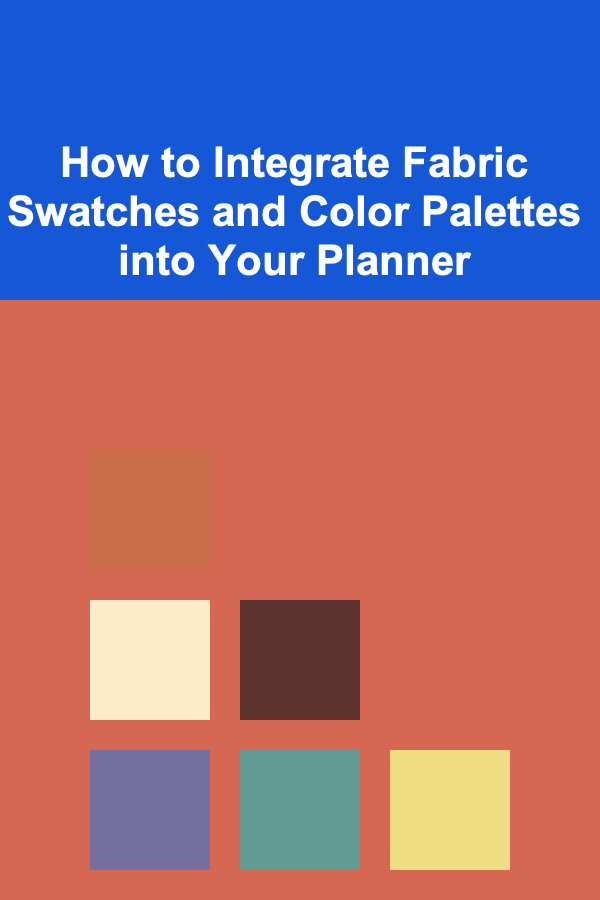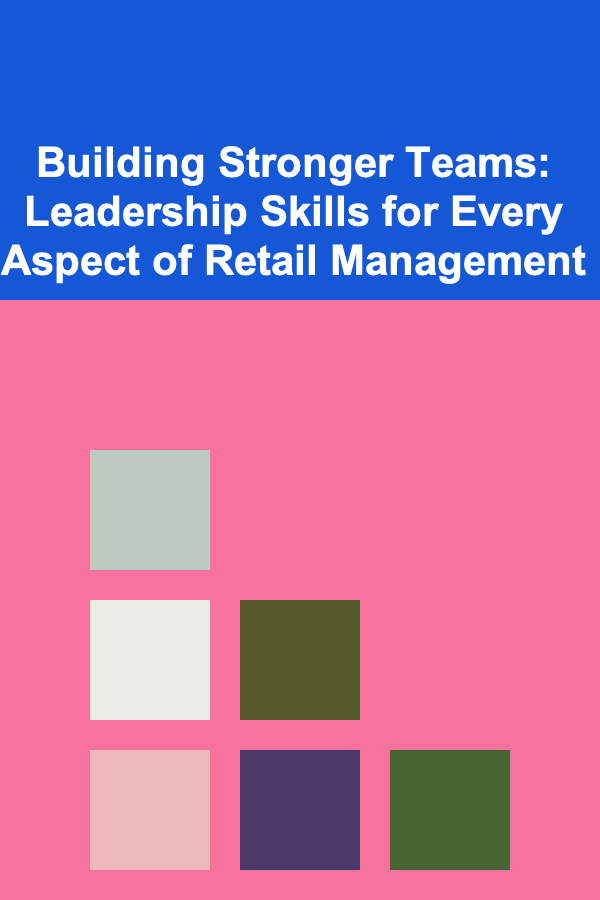
How to Integrate Fabric Swatches and Color Palettes into Your Planner
ebook include PDF & Audio bundle (Micro Guide)
$12.99$5.99
Limited Time Offer! Order within the next:

When designing a space, creating a fashion collection, or even planning an event, the importance of fabric swatches and color palettes cannot be overstated. These elements serve as the foundation for visual cohesiveness and help in bringing the concept to life. However, with so many design elements to juggle, it's essential to keep track of all the details, which is where a planner comes into play. Integrating fabric swatches and color palettes into your planner is a strategic way to keep your creative process organized and ensure that your design vision stays intact.
In this article, we'll explore how to efficiently incorporate fabric swatches and color palettes into your planner, whether you are an interior designer, fashion stylist, event planner, or just someone looking to organize creative projects. From practical techniques to digital tools, we will guide you on how to make the most out of your swatches and palettes while keeping everything neatly arranged.
Understanding the Role of Fabric Swatches and Color Palettes
Before diving into the specifics of integration, it's important to first understand the distinct roles that fabric swatches and color palettes play in the design process.
Fabric Swatches
Fabric swatches are small pieces of fabric that represent the materials you are considering using in your design projects. Whether it's for a clothing line, interior decoration, or a wedding, fabric swatches allow you to touch and feel the texture, weight, and drape of the fabric. These samples are crucial for ensuring that your final design will match your tactile expectations and that the materials chosen align with the overall vision.
Color Palettes
A color palette is a selection of colors that are chosen to work together harmoniously. In the world of design, a carefully curated color palette defines the mood and aesthetic of the project. Color palettes often consist of primary colors, accent colors, and neutrals. They can evoke emotions, highlight particular elements, or even provide contrast to create visual interest.
Together, fabric swatches and color palettes act as the tangible and intangible components that define the aesthetic direction of your project. They need to work together cohesively, which is why organizing them effectively in your planner is essential.
Choosing the Right Planner for Your Design Projects
When deciding to integrate fabric swatches and color palettes into your planner, the first step is choosing a planner that fits your needs. Not all planners are designed with creative projects in mind, so it's important to find one that can handle your materials and support your workflow.
Types of Planners to Consider
- Traditional Paper Planners: These are the most tactile and customizable. They offer flexibility in terms of organization, allowing you to create sections for swatches, notes, and sketches. Consider planners that have thicker paper and pockets, as they can better hold fabric swatches.
- Digital Planners: Digital planners, often in the form of apps, allow you to store everything from color palettes to scanned fabric swatches. They also make it easier to share and update your work on the go. Apps like GoodNotes, Notability, or even Google Keep can be customized to meet your needs.
- Project-Specific Planners: Some planners are specifically designed for particular industries, such as interior design or fashion. These planners may include pre-built sections for fabric swatches, color palettes, measurements, and inspiration. While these planners are more niche, they can be extremely helpful if you are working within a specific field.
Once you've selected the right planner for your needs, the next step is determining how to integrate your swatches and palettes effectively.
Organizing Fabric Swatches in Your Planner
Fabric swatches can be tricky to incorporate into your planner, as they are physical objects that take up space and come in varying sizes. However, there are several methods for storing and organizing these swatches in a way that keeps them accessible and manageable.
Using Plastic Sleeves or Pockets
One of the easiest and most effective ways to organize fabric swatches in your planner is by using plastic sleeves or pockets. Many planners, especially ring-bound planners, come with the option to add extra pockets or sleeves. These can be used to store and protect your swatches.
- Label the Pockets: You can label each pocket with the name of the fabric, its color, and its intended use. This makes it easy to locate specific swatches quickly.
- Sort by Project or Theme: If you're working on multiple projects, you can sort your swatches by project, season, or theme. For example, you might dedicate one section of your planner to fabrics for a fall fashion line and another section for materials for an interior design project.
Attaching Swatches to Pages
Another option is to physically attach fabric swatches to the pages of your planner. If your planner is bound or spiral-bound, you can use adhesive dots, fabric glue, or washi tape to secure swatches in place.
- Use Paper Clips or Binder Clips: For added convenience, you can clip swatches to the edge of planner pages. This allows you to move them around easily and attach multiple swatches to one page without worrying about the fabric falling off.
- Consider a Fabric Swatch Book: If you prefer a dedicated space for your fabric samples, you can create a fabric swatch book within your planner. This is essentially a mini binder that contains swatches with holes punched for easy insertion into your planner. You can organize the book by fabric type, color, or intended project.
Digital Fabric Swatches
If you prefer a digital approach, you can scan or photograph your fabric swatches and insert them into your digital planner. This allows you to keep your swatches organized without the bulk of physical materials.
- Use Apps to Capture and Store Swatches: Apps like Evernote, OneNote, or Google Keep allow you to store images of your fabric swatches, along with notes on texture, color, and usage. You can also tag your swatches by project or category for easy retrieval.
Integrating Color Palettes into Your Planner
Color palettes are an essential part of the design process, and integrating them into your planner can help you stay organized and on track. Much like fabric swatches, color palettes need to be easily accessible, so you can refer to them as you work.
Creating Physical Color Palettes
If you prefer working with tangible materials, you can use paint chips, colored pencils, or even printed swatches to create a physical color palette.
- Use Color Wheels or Swatch Cards: Many craft stores sell color wheels or swatch cards that display various colors. You can cut these swatches out and paste them into your planner for quick reference.
- Create a Color Palette Page: Dedicate a section of your planner to your color palettes. For each project, create a color palette page where you arrange color swatches and notes about the chosen hues. You can use small pieces of colored paper, paint chips, or markers to illustrate your palette.
Digital Color Palettes
For those who prefer digital tools, there are many ways to incorporate color palettes into a digital planner. Tools like Adobe Color, Coolors, or even Canva can help you create custom color palettes that you can then import into your digital planner.
- Use Color Code Systems: If you're working with digital color palettes, you can use hexadecimal (HEX) codes or RGB values to create an accurate record of your chosen colors. This is particularly helpful if you are working with a design team and need to communicate precise colors.
- Create Mood Boards: In addition to color palettes, mood boards are a great way to visualize the overall feel of your project. Tools like Pinterest or Milanote allow you to compile images, color swatches, and other inspiration into a digital mood board that can be integrated into your planner.
Maintaining Consistency Across Projects
When working on multiple projects that require both fabric swatches and color palettes, it's essential to maintain consistency in your planning system. Here are a few tips to ensure you stay organized:
Set Clear Sections for Each Project
Designate specific sections in your planner for each project you are working on. Whether it's a clothing line, an interior design project, or an event, each project should have its own dedicated space. This allows you to keep fabric swatches and color palettes organized and separate, reducing the risk of confusion.
Use Color Coding or Tabs
To make it even easier to navigate your planner, consider using color-coded tabs or labels. For example, you can assign a specific color to each project and use that color throughout your planner for fabric swatches, color palettes, and notes related to that project. This will make it quick to locate the relevant materials when you're deep into the design process.
Keep a Digital Backup
Even if you prefer a physical planner, it's a good idea to maintain a digital backup of your fabric swatches and color palettes. Scanning or photographing your swatches ensures that you always have a digital record in case of loss or damage.
Review and Update Regularly
The design process is fluid, and your choices of fabrics and colors may change over time. To ensure your planner remains a valuable tool throughout the creative process, make a habit of reviewing and updating your planner regularly.
- Review Fabric Swatches: Check the swatches you've chosen periodically to see if they still match your vision. If you've changed your mind or found new fabrics that work better, replace the swatches in your planner.
- Update Color Palettes: As you progress through your project, you may find that some colors work better than others. Make adjustments to your color palette as needed and add new color schemes as your design evolves.
By keeping your fabric swatches and color palettes up to date, your planner will continue to serve as a helpful reference that guides you through the design process.
Conclusion
Integrating fabric swatches and color palettes into your planner is a powerful way to stay organized and ensure your creative projects come to life seamlessly. Whether you're working on fashion, interior design, or event planning, keeping track of these essential elements is crucial for maintaining visual harmony and consistency. By selecting the right planner, organizing your materials efficiently, and regularly updating your content, you can transform your planner into a comprehensive tool that supports your design goals. With these strategies in place, you'll be well on your way to creating projects that are as visually stunning as they are well-organized.
Reading More From Our Other Websites
- [Organization Tip 101] How to Use the FIFO Method (First In, First Out) in Your Pantry
- [Home Budget Decorating 101] How to Rearrange Your Furniture for a Completely New Room Look
- [Scrapbooking Tip 101] How to Incorporate Hand‑Stitched Embroidery into Your Scrapbooking Projects
- [Skydiving Tip 101] Advanced Maneuvers Unlocked: Transitioning from Tandem to Solo Skydiving
- [Personal Financial Planning 101] How to Reduce Your Monthly Expenses Without Sacrificing Lifestyle
- [Home Budget 101] How to Save Money on Gas: Unconventional Strategies for the Everyday Commuter
- [Organization Tip 101] How to Organize Your Kitchen Utensils for Quick Access
- [Sewing Tip 101] Sewing Basics Made Easy: Must-Have Tools and Projects for Absolute Beginners
- [Home Soundproofing 101] How to Soundproof Your Home Without Sacrificing Style
- [Soap Making Tip 101] Troubleshooting Hot Process Soap: Common Mistakes and How to Fix Them

Building Stronger Teams: Leadership Skills for Every Aspect of Retail Management
Read More
Generating Revenue with AI-Powered Automation Tools
Read More
How to Balance Your Full-Time Job with Teaching Music Lessons Part-Time
Read More
How to Create a Welcoming Holiday Vibe with Outdoor Decorations
Read More
How to Curate Items That Represent Your Current Era
Read More
How to Plan for Regular Office Supply Audits
Read MoreOther Products

Building Stronger Teams: Leadership Skills for Every Aspect of Retail Management
Read More
Generating Revenue with AI-Powered Automation Tools
Read More
How to Balance Your Full-Time Job with Teaching Music Lessons Part-Time
Read More
How to Create a Welcoming Holiday Vibe with Outdoor Decorations
Read More
How to Curate Items That Represent Your Current Era
Read More